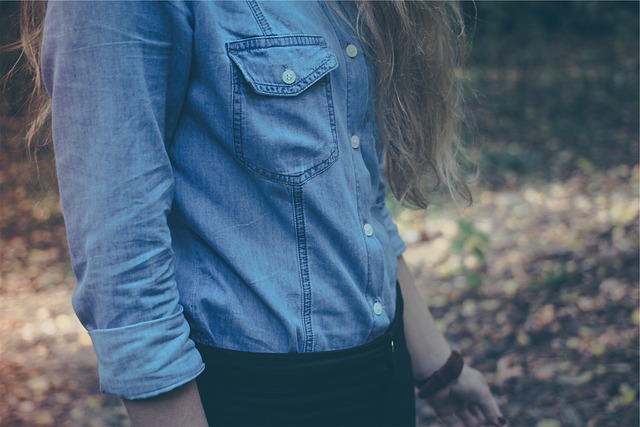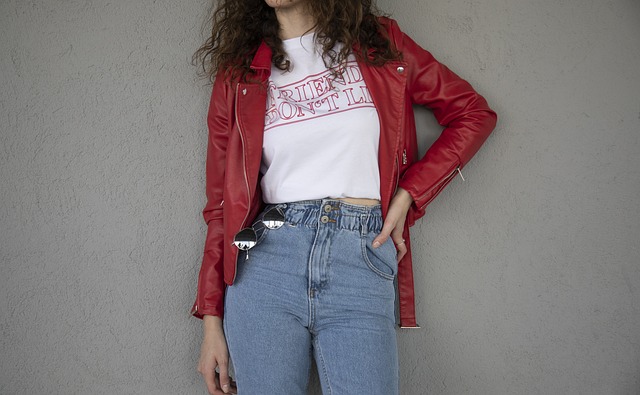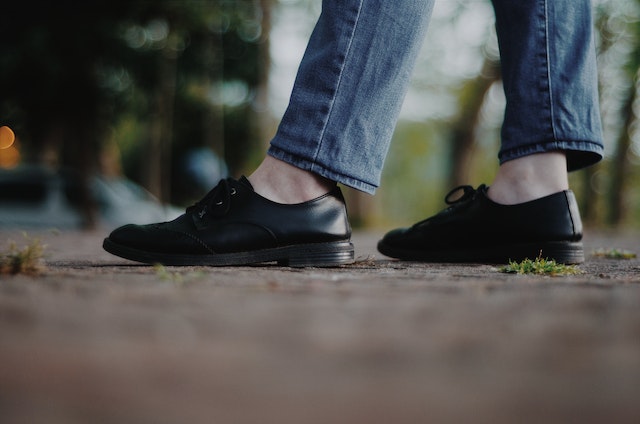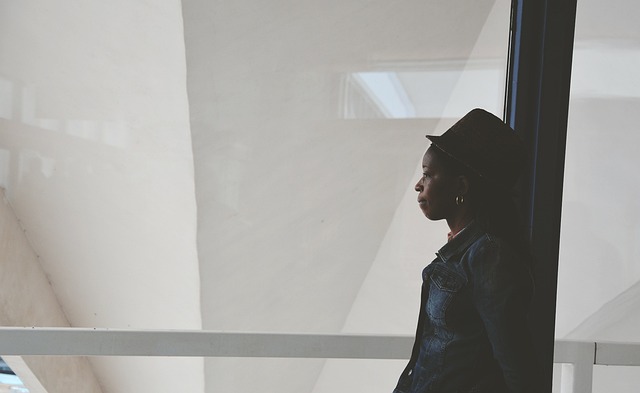
by MakeYourOwnJeans | Denim Shirts |
Denim has become synonymous with jeans. For over a century, it’s been the primary material in which men’s and women’s jeans are made. But denim is now used in the construction of other articles of clothing, such as shirts. Denim shirts offer a comfortable, stylish alternative to traditional shirts. As their name suggests, they are made of denim. Denim is a type of durable warp-faced textile consisting of cotton. It’s made by passing the weft thread under two or more warp threads. Using this weaving pattern, denim has diagonal ribbing that sets it apart from other common textiles. How do you choose a denim shirt exactly? Short Sleeve vs Long Sleeve When shopping for a denim shirt, one of the decisions you’ll have to make is whether you want a short-sleeve or long-sleeve style. Both styles are made of denim. Short-sleeve denim shirts simply have short sleeves, whereas long-sleeve denim shirts have long sleeves. Short-sleeve denim shirts are ideal for the warmer months of the year. If you’re looking for a new denim shirt to wear during the spring and summer, you may want to go with a short-sleeve style. It will leave your arms exposed to the surrounding air, thereby keeping you cooler and more comfortable even when it’s hot outside. If you’re looking for a new denim shirt to wear during the fall and winter, on the other hand, you may want to go with a long-sleeve style. Long-sleeve style denim shirts completely cover the arms when worn, resulting in better protection against the cold weather. Choose a Versatile Color You should choose a denim shirt in...

by MakeYourOwnJeans | jeans |
Looking to cuff your jeans? We have you covered. Whether they are made of plain denim or stretch denim, you can cuff your jeans in just a few easy steps. It will create a cleaner appearance while ensuring that your jeans don’t drag on the ground. The Basics of Cuffing and What It Means Cuffing is the process of rolling up the bottom or hem of the pant legs. The origins of this fashion trend can be traced back to the 1950s. During this period, men and women alike regularly cuffed their jeans. It allowed them to stand out by projecting a more unique style. While many fashion trends have come and gone since the 1950s, cuffing is still around. You can cuff your jeans by rolling up the bottom a few inches. Cuffing isn’t exclusive to jeans. Other types of pants and trousers can be cuffed as well. Regardless, the term “cuffing” refers to the process of rolling up the bottom or hem of the pant legs. A proper cuff should remain in place. In other words, the bottom of the pant legs shouldn’t become unrolled. You can wear cuffed jeans or other types of cuffed pants all day long. Reasons to Cuff Your Jeans There are several reasons to consider cuffing your jeans. It can help you achieve a more balanced proportion. Cuffing will essentially create a balanced proportion between the length of your jeans and the height of your body When cuffed, your jeans won’t drag on the ground. It’s not uncommon for oversized jeans to drag on the ground. If they are just one size...

by MakeYourOwnJeans | jeans |
Choosing jeans in the right size for your body is essential to a comfortable fit. If they are too big or too small, you may not be able to wear them. And even if you’re able to put them on, they may cause discomfort. You can avoid problems such as these by choosing jeans in the right size. There are several different measurements in which jeans are made, however. While you might be familiar with traditional length and waist sizes, there are other measurements to consider. By familiarizing yourself with the following jean measurements, you’ll have an easier time finding the perfect size for your body. Inseam Inseam is a common measurement for jeans. Whether you’re shopping for stretch jeans, boot-cut jeans, cropped jeans or any other style, you should consider the inseam. What is inseam exactly, and how do you measure it? The term “inseam” refers to the distance from the bottom of the pant legs to the bottom of the crotch. You can measure it by taking a tape measure — use a fabric tape measure for the best results — and running it from the hem at the bottom of the pant legs all the way to the bottom of the crotch. The distance between these two points is the inseam. The longer the inseam, the longer the jeans will be. Outseam In addition to inseam, there’s outseam. Jeans have both an inseam and outsteam. While some people assume these two measurements are the same, this isn’t the case. Inseam and outseam represent different areas of jeans. The term “outseam” refers to the distance from the...

by MakeYourOwnJeans | Jackets |
You can’t go wrong with a denim jacket. Also known as a jean jacket, it’s a classic form of outerwear that’s perfect for men and women alike. Denim jackets have been around for centuries. The world’s first denim jacket was released in the early 1800s as part of the German Historical Commission of the Rhineland. In the United States, denim jackets were commonly worn by cowboys, ranchers, railroad workers and miners. Little has changed regarding their design since then. Denim jackets are still made of the same denim material, and they are available in the same styles. If you’re thinking about buying a denim jacket, however, you should follow these tips to make a last a lifetime. Choose a High-Quality Denim Jacket The quality of your denim jacket matters. While they are all made of denim, some denim jackets are of higher quality than others. They feature better denim materials and craftsmanship, resulting in a superior level of quality compared to other denim jackets. High-quality denim jackets are better protected against premature wear and tear than low-quality denim jackets. They can withstand greater stress without succumbing to the hands of time. Therefore, if you want to get the most use out of it, you should choose a high-quality denim jacket, such as those sold here at MakeYourOwnJeans. How do you know if a denim jacket is high quality exactly? Here are some telltale signs of a high-quality denim jacket? Pre-washed and pre-shrunkMade of 100% cotton denimMid-weight (12 ounces) constructionSide welt pocketsChest pocketsPremium, non-plastic buttonsButtons on the cuffs Unfasten Buttons When Washing and Drying Assuming you choose a denim jacket...

by MakeYourOwnJeans | denims |
When most people think of denim, they envision jeans. Jeans are characterized by a denim construction. You can find jeans in a variety of colors, sizes and styles, but they are all made of denim. Not all denim is the same, however. There are many different types of denim, each of which features unique properties that distinguish it from the rest. What are the different types of denim exactly? Distressed Denim You’ve probably heard of distressed denim. As shown in the photo below, it’s characterized by an intentionally worn and degraded appearance. Manufacturers make distressed denim using chemical and/or physical treatments. Submerging denim in a bath of acid, for instance, is a chemical treatment used in the production of distressed denim. Exposing denim to pumice stones, on the other hand, is a physical treatment. They involve different processes, but chemical treatments and physical treatments have the same effect: They wear down and degrade denim so that it looks older and more worn in. Distressed denim jeans have an aged, worn-in appearance that distinguishes them from other jeans made of non-distressed denim. Raw Denim The term “raw denim” refers to denim that hasn’t been washed or otherwise exposed to water during production. Also known as dry denim, it’s made using a loom — just like most other types of denim. Raw denim, though, isn’t washed or exposed to water during production. After coming off the loom, it’s used to make jeans, denim jackets, denim skirts and other garments and accessories. You may discover that raw denim has a darker color than other types of denim. It’s still dyed during production,...
















